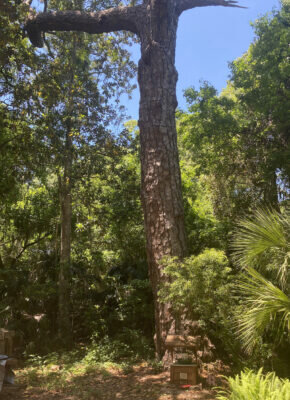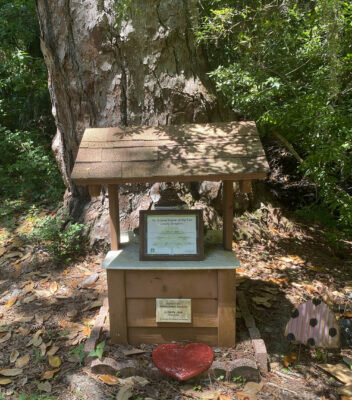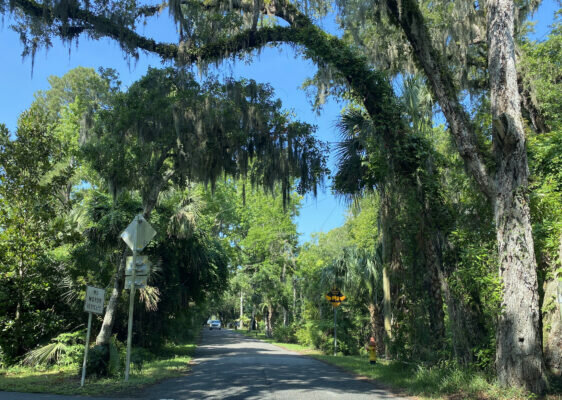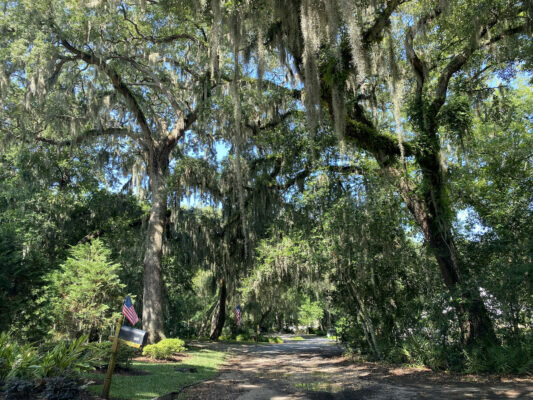Pat’s Wildways: All Trees are Special
 The champion loblolly towers over Tony’s yard.
The champion loblolly towers over Tony’s yard.
I can’t believe that it was 17 years ago that I wrote a column in the News-Leader about Tony Lopez and the Florida Champion loblolly tree that he is protecting in his yard off Buccaneer Trail midway on Amelia Island. I got interested again when I researched a recent column about the new development proposed in that area of the island. How was this giant tree doing these days, I wondered? So, once again, I contacted Tony, and soon enough, I was touring his yard and marveling at this healthy, famous tree.
Back in 2007, this tree was officially measured by a forester to be 105 feet tall, 14 feet, 4 inches in girth, and with an average crown spread of 64 feet. Official measurements are made every five years. The latest measurements show that this tree is now 15.7 feet in diameter, aging and growing wider, just like me. Its other competitor for the largest Florida Champion loblolly pine tree has since died, and now, according to the Florida Champion tree site, Tony’s tree is now the biggest loblolly pine in the state and has received national recognition and a certificate from the American Forests organization. This tree is important to Tony and he works to ensure it is not harmed. Although a core sample could determine its age and a lightning rod on top could protect it from lightning strikes, that involves climbing the tree to install and Tony is very cautious. No one is going to harm this tree if he can help it!
 A shrine of sorts honors the champion loblolly pine tree that Tony Lopez is protecting.
A shrine of sorts honors the champion loblolly pine tree that Tony Lopez is protecting.There are two other Florida Champion trees on Amelia Island too: a sugarberry tree on Garden Street in Old Town that is on property owned by arborist Chris Hastings and a tough bumelia on Alachua Street between Ninth and 10th streets that was discovered and nominated by then city arborist Dave Holley. No doubt other deserving trees on Amelia Island can also be discovered, and with some work, they too can be registered as champion trees for their species.
And then there are heritage trees on Amelia Island. These trees may not be the largest of their species, but they have been nominated and deemed important due to their “size, age, historic, aesthetic or cultural significance.” Think of many of the large live oaks scattered around our city. The city of Fernandina Beach has a protocol where people, organizations or officials can designate certain trees as heritage trees. But regardless of protection efforts many mature trees are continually being removed from our island to make room for more houses and businesses.
 Buccaneer Trail is a canopy road that may be threatened by further development.
Buccaneer Trail is a canopy road that may be threatened by further development.When I was pondering the loss of trees, I spent some time driving around the canopy roads of Amelia Island. Canopy roads are another designation designed to protect our trees. Nassau County has a canopy roads program and a number of stretches of our roads have been thus designated. According to the website, “The County shall not widen or increase the number of lanes on any of the county roads designated as scenic/canopy roads,” and there are other restrictions as well.
Much of Buccaneer Trail that parallels Amelia Island Parkway is a canopy road that many of us travel frequently when heading south on the island. So far, it is a scenic drive past the golf courses, then under the inspiring canopy of live oak trees. But this time, driving along the canopied stretch of this road, I was filled with apprehension. If a new development of 24 homes is built off Shadow Woods Lane with increased traffic exiting on Buccaneer Trail I think there will soon be a problem there. Many of the live oak trees along the canopy stretch have trunks very close to the road. At some point, the road will have to be widened for safety reasons and there goes the canopy, designated canopy road or not. The residents at the now-dirt Shadow Woods Lane have also submitted a canopy road application to Nassau County months ago, but there has been no action on their application as of yet. And if this development proposal goes through, the entire character of this long-standing neighborhood will be changed forever.
 Shadow Woods Lane is now a shaded dirt road that may be completely altered if a proposed new development is built and traffic is routed there.
Shadow Woods Lane is now a shaded dirt road that may be completely altered if a proposed new development is built and traffic is routed there.If you too are concerned about the loss of trees on Amelia Island, there are thousands of like-minded people who support the Amelia Tree Conservancy (ATC) in an effort to protect our remaining trees. Their motto is “Protecting the Canopy that Protects Us.” ATC welcomes your membership and participation in these efforts.
Yes, trees provide shade, shelter, wildlife food and habitats -- all of that. But our champion, heritage and canopy trees and all the rest that still remain have great aesthetic value too. It’s part of what Amelia Island is! I hate to see it disappear in my lifetime.
Pat Foster-Turley, Ph.D., is a zoologist on Amelia Island. She welcomes your nature questions and observations. [email protected]





